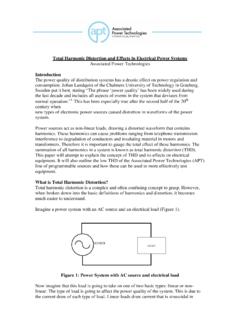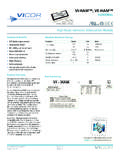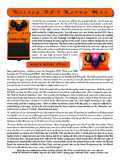Transcription of Intermodulation Distortion IMD - TI.com
1 1994 Burr-Brown CorporationAB-194 Printed in April, 1994563421 The Intermodulation Distortion (IMD) performance ofwideband, DC-coupled amplifiers is a relatively new areafor integrated operational amplifier suppliers. New progressesin IC technology extend the application of op amps wheresome years ago discrete circuits played the major to measure and communicate the extent of thisdistortion to users have been borrowed from traditional RF companies which have historically supplied the radarand radio communications industries, where the importanceof it was first of applications demanding good intermodulationdistortion include: Radar Satellite Communications Digital Radio Receivers Nuclear Particle Research CAD Monitor AmplifierIn radar applications good IMD performance is essential,because interference from other radars and jammers oftenpollute the spectrum.
2 For satellite communications systems,the usable bandwidth for each transponder is limited andmultiple signals are frequency multiplicated onto one carrierso that signals can interfere with each other when IMDperformance is low. For Digital Radio Receivers, a smallsegment of a broader RF spectrum is digitized and scannedby high-speed data signal processors. For CAD MonitorAmplifiers and for Nuclear Particle Research test equip-ment, the IMD or as later described the intercept pointcharacterize more precisely than harmonic Distortion thelarge signal capabilities of wideband DISTORTIONIN THE OPA622 AND OPA623 The IMD test results in this application note center on newultra high-speed operational amplifiers available from Burr-Brown notably, the OPA622 voltage feedback amplifierand the OPA623 current-feedback the specifications are important and are fully tested,the targeted market segments for these amplifiers clearlycalled for superior AC performance.
3 Enhanced testing forthese parts includes 3dB bandwidth curves for variousgains and output voltage swings, group delay time, settlingtime, rise time, slew rate, harmonic Distortion , and IMDperformance. In the remaining sections the application notedescribes the basics of Intermodulation distortions, the rela-tionship between fundamental and 3rd IMD, and shows thetest setup and test results for the OPA622 and DISTORTIONWhen Flash-A/D users talk about Distortion they are gener-ally concerned with the spurs introduced into the spectrumof interest. In laboratory conditions harmonic Distortion is amajor area of concern and is usually measured by insertinga single-tone fundamental into the DUT, then looking at therelevant frequency (2xf, 3xf) to determine the magnitude ofthe harmonic tones.
4 While this testing is useful to manycustomers, it does not always appease everyone. Manufac-turers who claim to have amplifiers with 3dB bandwidth inthe tens of MHz region often test Distortion at relatively lowtones. While the results are undoubtedly favorable, the usercannot use it for a circuit design. Harmonic Distortion alsoneglects the magnitude of spurs from other sources. Installedin the equipment for which it was selected, there is noguarantee that it will be exposed to a pure spectrum as it isfor harmonic Distortion measurements. In many cases theamplifier is asked to operate in spectrally-rich environmentswhere Intermodulation Distortion properties of the amp areof keen DERIVATIONOF Intermodulation DISTORTIONThe usable dynamic range of an amplifier is limited at verysmall signal levels by the noise floor and at large signallevels by interferences between signal frequencies.
5 Distor-tions are caused by non-linearities in the amplitude transfercharacteristics. As shown later for producing harmonics, thetransfer curve exists of a linear and a quadratic portion andthe typical output contains not only the fundamental fre-quency, but integer multiples of it. IMD results from themixing of two or more signals of different frequencies andthe transfer curve contains in addition a cubic portion. Thespurious output occurs at the sum and/or difference ofinteger multiples of the input Distortion (IMD)By Christian Henn, Burr-Brown International, GmbHAPPLICATION BULLETIN Mailing Address: PO Box 11400 Tucson, AZ 85734 Street Address: 6730 S. Tucson Blvd. Tucson, AZ 85706 Tel: (602) 746-1111 Twx: 910-952-111 Telex: 066-6491 FAX (602) 889-1510 Immediate Product Info: (800) 548-6132 SBOA0772 VOUT=K0+K1(VIN)+K2(VIN)2+K3(VIN)3+LBias PointVIIAVKVBBPFIGURE 1.
6 Nonlinear Transfer non-ideal characteristics of an amplifier can be de-scribed by using the Power Series Expansion:A one-tone input signal (V = Esin t) produces harmonicdistortion, a two-tone input signal produces harmonic distor-tion and Intermodulation 1t+E2sin 2tCombining equations 1 and 2 results in the following iden-tity: VOUT=K0+K1(E1sin 1t+E2sin 2t)2+K2(E1sin 1t+E2sin 2t)2+K3(E1sin 1t+E2sin 2t)3+LThe first term (K0) represents the DC offset of the amplifier,the second term is the fundamental signal(s). The subse-quent terms represent the Distortion of the amplifier. Thesecond IMD can be found by analyzing the third term ofEquation (VIN)2=K2(E12sin2 1t+E22sin2 2t+2E1E2sin2 1t(sin 2t))(1)(2)(3)(4)(5c)(5a)(5b)Term (a) from Equation 7 represents amplitude offset at thefundamental frequencies.
7 Term (b) signifies the third-orderharmonics. Term (c) and (d) represent third-order result clearly indicates that IMD and crossmodulationonly occur on a curved transfer characteristic with cubicterms like term (c) and (d) in Equation 7. In contrast atransfer characteristic with a linear and quadratic portiongenerates the mixing products (sum and difference) and theharmonics of the input SIMPLE RELATIONSHIPSI ntermodulation Distortion occurs at frequencies that are thesum and/or difference of integer multiple of the fundamentalfrequencies. For example, assume a composite signal hasfundamental frequencies l and 2. Distortion products willoccur at frequencies a l b 2 where a and b = 0, 1, 2, 3.
8 The following table illustrates this Frequencies3rd-Order Frequencies 1 22 1 + 2 2 2 + 1 1 + 22 1 2 2 2 1 TABLE I.(7a)(7b)(7c)(7d)(6)Utilizing the identities, sin3x = 1/4(3sin sin3x) and sin2xsiny= 1/2(siny 1/2(sin(2x + y) sin(2x y))), Equation 6reduces to:The first and second terms in Equation 5 represent DC offsetand second-order harmonics. The third term is the second-order IMD. This exercise can be repeated with the fourthterm of Equation 3 to study third-order that [sin2x = (1 cos2x)/2] and [sin(x)sin(y)= (cos(x y) cos(x + y))/2] and substituting intoEquation 4 provides:K3(VIN)3=(3K3/4)(E13sin 1t+E23sin 2t+2E12E2sin 2t+2E22E1sin 1t)(K3E23/4)(E13sin 3 1t+E23sin 3 2t)+(3K3E12E2/ 2)(sin(2 1t 2t) 12sin(2 1t+ 2t))+(3K3E22E1/ 2)(sin(2 2t 1t) 12sin(2 2t+ 1t))K2(VIN)2=K2(E12+E22)/2 (K2/2)(E12cos 2 1t+E22cos 2 2t)+2K2E1E2(cos( 1t 2t) cos( 1t+ 2t))K3(VIN)3=K3(E13sin3 1t+E23sin3 2t+3E12E2sin2 1t(sin 2t)+3E1E22sin 1t(sin2 2t)33rd IMD Harmonic SuppressionFundamental Signals 20 MHz = 1.)
9 21 MHz = 23rd IMDs 22 MHz = 2 2 1 19 MHz = 2 1 22nd IMD 41 MHz = 2 + 12nd IMD 1 MHz = 2 1 FrequencyAmplitudeMost IMD can be filtered out. However, if the input tonesare of similar frequencies, the third-order IMD (2 l 2,2 2 l) will be very close to the fundamental frequenciesand cannot be easily filtered. Third-order IMD is of mostconcern in narrow bandwidth applications. Second-orderIMD is of greater concern in broad bandwidth 2 below illustrates on a spectrum analyzer the outputspectrum of two frequencies (fl, f2) applied to the non-lineartransfer characteristic of a mixer with an overdrive level 8 shows that if the input level (dB) increases, thelevel of the third-order IM products increases three 4 shows the graphic presentation of the theoreticalincrease of the IMD products when the level increases.
10 Thedesired output of an amplifier and any IMD can be repre-sented by two straight lines of different slopes. The desiredoutput lines have a slope of +1, any IMD has a slope of n,where n is the order of , the third-order IMD has a slope of can be seen in Figure 4 for low level input signals theoutput tracks the input. At higher input levels Gain Com-pression occurs at the point where the actual output powerdrops below the ideal. The 1dB gain compression point isa well accepted performance parameter for RF intercept point can be found at the intersection of thetheoretical line extension of output signal and IMD. Theintercept point can be determined from the value of theharmonic suppression ( IM) which must be determinedexperimentally.


















